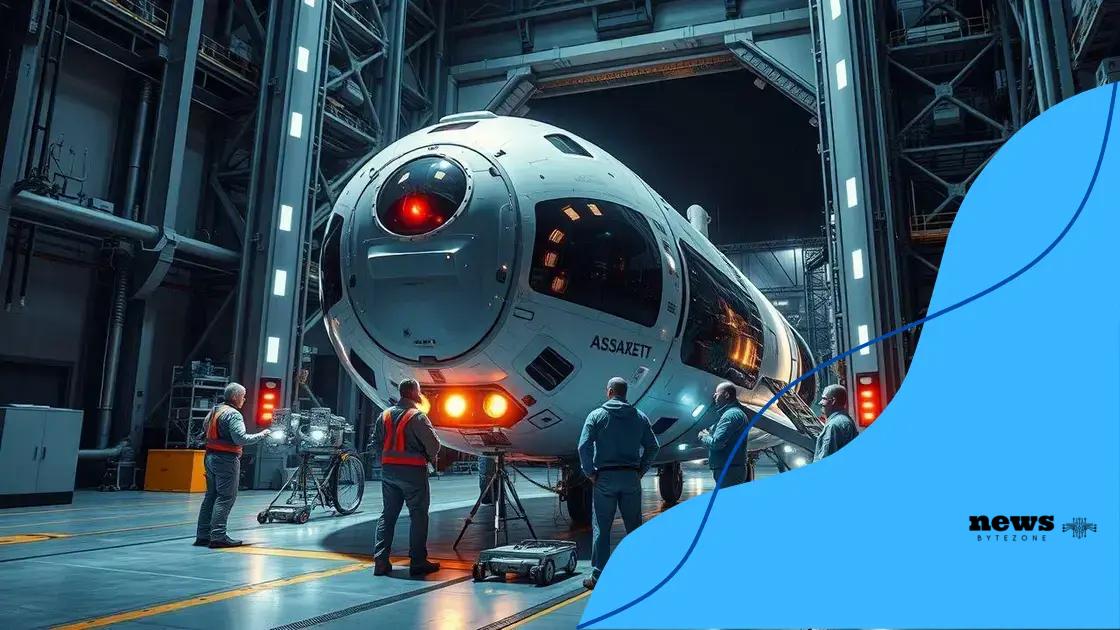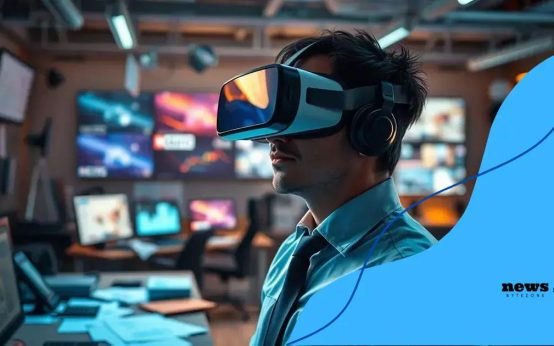Space tourism enables private individuals to travel beyond Earth for recreational experiences, driven by innovations in safety, cost reduction, and evolving technologies from leading companies like SpaceX and Virgin Galactic.
Space tourism: preparing for the final frontier of travel is more than just a dream; it’s becoming a reality. Have you ever imagined floating in zero gravity or gazing at Earth from above? Let’s explore how this incredible journey is unfolding.
Understanding space tourism
Understanding space tourism is crucial to grasping the future of travel. It combines adventure, technology, and exploration in ways we’ve only dreamed of. As companies race to offer trips beyond our atmosphere, it’s essential to understand the factors that make this exciting reality possible.
What is Space Tourism?
Space tourism refers to the commercial activity of sending private individuals into space. It allows ordinary people to experience the thrill of space travel without needing any specific training. This industry is evolving rapidly, with more companies entering the scene.
Key Players in the Industry
Several companies are leading the charge in space tourism:
- SpaceX: Known for its reusable rockets and ambitious missions, they offer journeys to the International Space Station.
- Blue Origin: Their New Shepard spacecraft is designed for suborbital flights, providing a few minutes of weightlessness.
- Virgin Galactic: With their SpaceShipTwo, they aim to take tourists to the edge of space.
These companies are not just creating flights; they are shaping the future of how we perceive travel beyond Earth. Each flight opens doors to new possibilities and a different understanding of our planet.
As technology advances, the costs of these journeys might decrease, making space tourism more accessible to a broader audience. With experiences that include viewing the curvature of the Earth and experiencing microgravity, enthusiasts are eager to book their tickets. Individuals dreaming of space travel can find inspiration through these innovative ventures.
Who are the pioneers of space travel?
Who are the pioneers of space travel? This question opens a fascinating discussion about the individuals who have pushed the boundaries of exploration. From visionary leaders to brave astronauts, these pioneers have shaped the path for future generations of space tourists.
Key Figures in Space Travel
Several trailblazers have laid the groundwork for modern space travel. Their contributions are critical to the advancements we see today:
- Yuri Gagarin: The first human to travel into space in 1961, Gagarin’s mission marked a monumental achievement in the Space Race.
- Neil Armstrong: Known for being the first person to walk on the Moon in 1969, Armstrong inspired millions with his famous words, “That’s one small step for a man, one giant leap for mankind.”
- Bob Bigelow: A key figure in the development of inflatable space habitats, Bigelow has been a strong advocate for expanding human presence beyond Earth.
These pioneers not only achieved historic milestones but also inspired a series of innovations. For instance, Armstrong’s journey prompted nations and companies to invest more heavily in space exploration. As we look at the future of space tourism, it’s essential to remember these foundational figures.
Modern Innovators
With the advent of commercial space travel, new pioneers are emerging. Entrepreneurs like Elon Musk and Richard Branson are now at the forefront. Musk’s SpaceX has revolutionized spacecraft design and launch efficiency. On the other hand, Branson’s Virgin Galactic is paving the way for suborbital space tourism.
As these modern pioneers take us closer to the stars, they cultivate excitement and curiosity about space travel. Each flight highlights the potential for adventure that awaits those willing to explore the unknown.
Current challenges in space tourism

Current challenges in space tourism are significant as this industry progresses. While the idea of traveling to space is thrilling, there are various hurdles that need to be overcome. Understanding these challenges helps in preparing for the future of space exploration.
Cost and Accessibility
One of the biggest challenges in space tourism is the high cost of travel. Currently, a ticket to space can range in the hundreds of thousands to millions of dollars. This makes it accessible only to a small number of wealthy individuals. As costs remain high, many companies are working to find ways to reduce expenses. Innovations in technology and manufacturing can help lower the price of space flights.
Safety Concerns
Safety is a critical issue in the field of space travel. Space travel involves risks that must be addressed. Companies are focusing on improving safety measures and protocols, but no journey is without danger. The development of reliable spacecraft and thorough training programs for space tourists is vital.
- Engine Failures: Problems with rocket engines can lead to dangerous situations.
- Space Debris: Collisions with debris in orbit pose risks to spacecraft safety.
- Health Risks: The effects of microgravity on the human body need careful consideration.
As companies tackle these challenges, they continually seek ways to ensure safer, more enjoyable experiences for tourists.
Regulatory Hurdles
The regulatory landscape for space tourism is still developing. Governments worldwide are establishing guidelines and regulations for commercial space travel. This can affect how quickly companies can launch services. Navigating these regulations is a challenge for many companies aiming to enter the space tourism market.
In conclusion, while space tourism is an exciting frontier, it is crucial to address the challenges presented. By overcoming barriers related to cost, safety, and regulations, the industry can evolve and become more accessible to a broader audience.
The future of commercial space flights
The future of commercial space flights holds immense promise as technology advances and more companies enter the field. As we look ahead, various factors will shape this exciting industry.
Emerging Technologies
Innovations will play a crucial role in the future of space tourism. Companies like SpaceX and Blue Origin are at the forefront of developing reusable rockets. These rockets are designed to lower costs, making space travel more accessible. By reusing parts of the spacecraft, companies can significantly reduce launch expenses and the environmental impact.
Increased Accessibility
As technology progresses, the dream of space travel may become a reality for more people. The goal is to offer flights to ordinary citizens, not just the wealthy elite. Developing affordable tickets can broaden the market significantly.
- Suborbital Flights: Short trips that allow passengers to experience weightlessness.
- Orbital Hotels: Concepts for space lodging are becoming a reality, providing unique vacation experiences.
- Education and Research: Opportunities for students and researchers to participate in missions.
With these advancements, the perception of space will shift. More individuals will consider space travel as a feasible option for adventure and learning.
Environmental Considerations
As we grow excited about commercial space flights, we must address environmental concerns. Space launch emissions can impact the atmosphere, and scientists are researching ways to minimize these effects. Sustainable practices will be vital in maintaining the balance between exploration and environmental responsibility.
Discussions surrounding regulation will also be pivotal as new players emerge in the industry. Governments will need to create frameworks to ensure safety, environmental protection, and fair competition. Collaboration between public and private sectors is essential for responsible growth.
Safety measures in space tourism
Safety measures in space tourism are critical as the industry grows. With more companies planning to send civilians to space, ensuring passenger safety is a top priority. Various protocols and technologies are emerging to address safety concerns.
Training for Space Tourists
Before embarking on a space journey, tourists undergo specific training. This training prepares them for the unique challenges of space travel. Participants learn about safety procedures, how to use equipment, and the effects of microgravity. Understanding these factors helps passengers stay calm and ready during their flight.
Advanced Technology
Spacecraft technology is continually evolving to enhance safety. New systems are being developed to monitor performance and detect issues early. Features like automated safety checks and real-time diagnostics play a crucial role.
- Redundant Systems: Spacecraft are designed with backup systems to ensure functionality in case of a failure.
- Launch Abort Systems: These systems can safely separate a spacecraft from its rocket in emergencies, protecting passengers.
- Health Monitoring: Advanced monitoring systems keep track of passenger health during the flight.
As technology advances, these features will become more reliable, increasing safety standards in the industry.
Regulations and Standards
Governments are creating regulations to govern space tourism. These rules focus on safety, environmental impact, and commercial operations. Companies must comply with these guidelines to obtain necessary licenses for their flights. Collaboration between governments and private space companies ensures that safety remains a priority.
The future of space tourism poses challenges and excitement. Developing effective safety measures will be vital as more individuals seek adventures beyond Earth. These efforts will help build trust among potential space travelers and pave the way for a new era of exploration.
Conclusion: The journey toward space tourism is filled with excitement and challenges. As technology advances, more people will have the chance to explore the final frontier. Key factors like enhanced safety measures, emerging technologies, and regulatory frameworks will help shape this industry. By addressing current challenges, we can ensure that space travel becomes a safe, enjoyable adventure for everyone. The future of space tourism is bright, and it invites us all to dream big and reach for the stars.
FAQ – Frequently Asked Questions about Space Tourism
What is space tourism?
Space tourism refers to commercial trips where private individuals can travel into space for recreational, leisure, or adventure purposes.
How much does a ticket for space tourism cost?
The cost of a ticket for space tourism can range from hundreds of thousands to millions of dollars, depending on the company and the type of experience.
What safety measures are in place for space tourists?
Safety measures include rigorous training for passengers, advanced spacecraft technology, and strict regulatory compliance to ensure a safe journey.
What companies are leading the space tourism industry?
Leading companies include SpaceX, Blue Origin, and Virgin Galactic, each offering unique experiences and advancements in commercial space travel.

 Virtual reality in journalism: immersive storytelling techniques
Virtual reality in journalism: immersive storytelling techniques  The impact of 5G on rural connectivity and development
The impact of 5G on rural connectivity and development  The ethics of deepfake technology and its implications
The ethics of deepfake technology and its implications